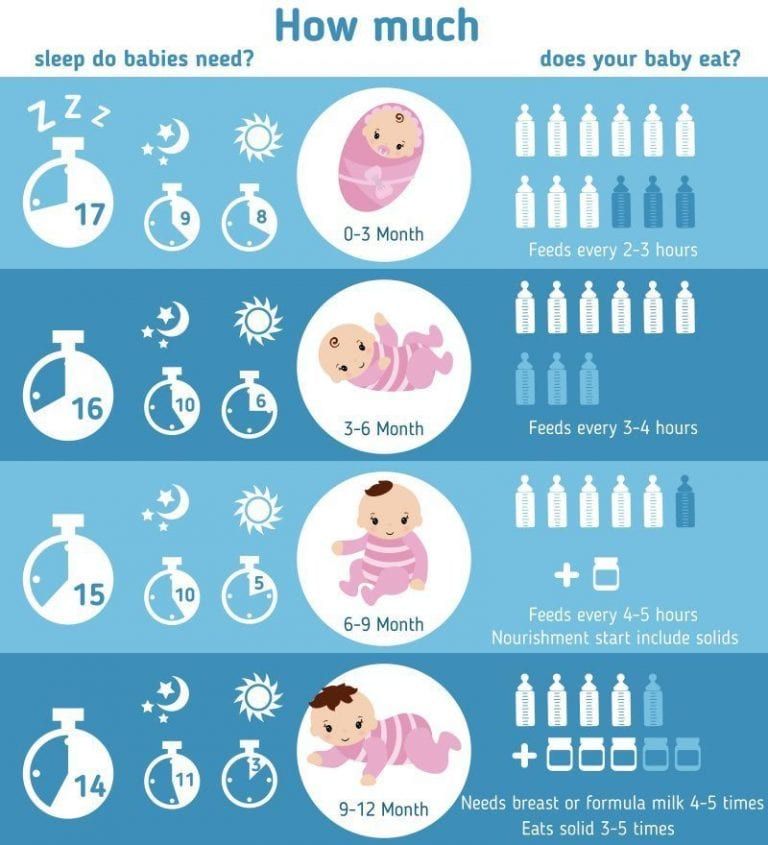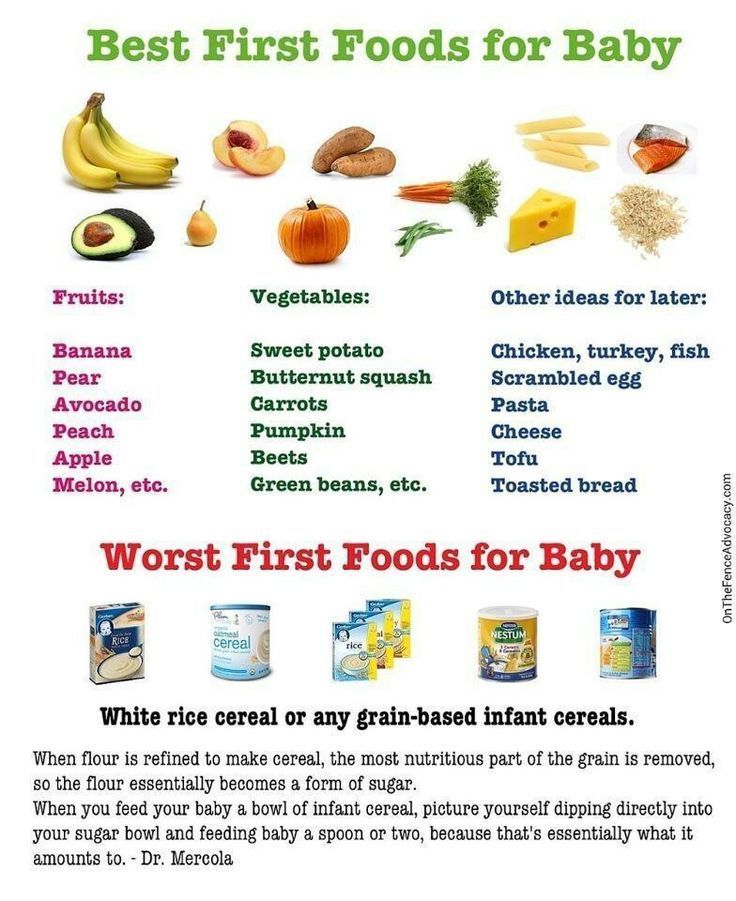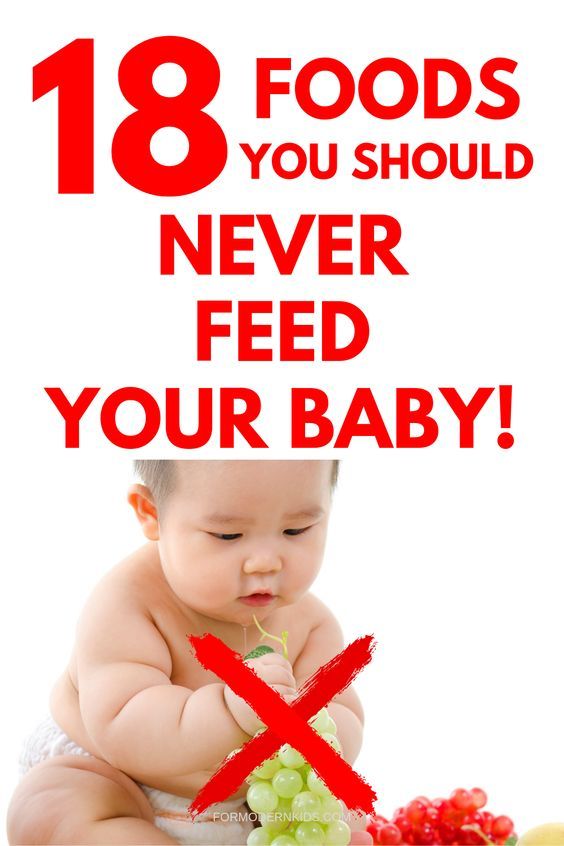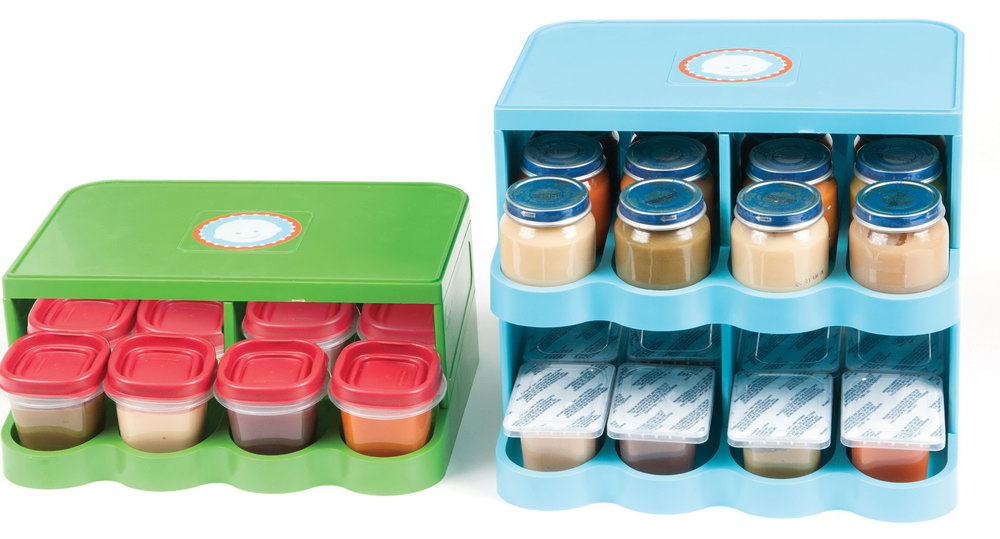Dangers of feeding baby solids too soon
Most babies are fed solid food too soon, study finds
Health news
By Linda Carroll
Most mothers may be starting their infants on solid foods months sooner than specialists recommend, mistakenly believing their children are old enough to graduate from breast milk or formula – but many say they’re simply following doctors’ orders, according to a study published today.
Parents should wait until their little ones are at least 6 months old before offering them solid foods, say many child-nutrition experts, including the American Academy of Pediatrics.
But researchers at the Centers for Disease Control and Prevention – who surveyed 1,334 new moms – discovered that almost 93 percent of those women had introduced solid foods to their infants before 6 months, that 40 percent did it before the 4-month mark, and that 9 percent had offered solids to their babies before they were even four weeks old, according to the study, published today in Pediatrics.
“Fifty percent said that their health care provider told them it was time to introduce solid food,” said Kelley Scanlon, a co-author of the study and lead epidemiologist in the nutrition branch in the division of nutrition, physical activity and obesity at the CDC.
“That, for us, indicates that health care providers need to provide clearer guidance and really support women in carrying out the recommendation,” Scanlon said.
Physicians' groups settled on the 6-month cut-off after earlier research determined that children who get solid food at too early might be at a greater risk for developing chronic diseases, such as diabetes, obesity, eczema and celiac disease, Scanlon said.
The mothers who volunteered for the CDC study filled out food diaries and questionnaires designed to ferret out their opinions on why and when solid foods should be offered.
Among the moms offering solid foods to infants younger than 4 months, the most commonly cited reasons for doing so included: “My baby was old enough;” “My baby seemed hungry;” “I wanted to feed my baby something in addition to breast milk or formula,” “My baby wanted the food I ate;” “A doctor or other health care professional said my baby should begin eating solid food;” and “It would help my baby sleep longer at night,” researchers reported.
What’s more, moms who fed their babies formula were far more likely to start solids too early versus those who exclusively breast-fed (53 percent versus 24 percent), the study showed.
One food expert unaffiliated with the CDC study suggested that some health-care providers may simply be unfamiliar with current baby-feeding recommendations.
“I think this is worrisome,” said Ann Condon-Meyers, a pediatric dietician at the University of Pittsburgh Medical Center and Children's Hospital of Pittsburgh. “I think it may show that word isn’t getting out that … it is 6 months before solid foods should be offered.”
Still, the study’s findings didn’t surprise Condon-Meyers, who added: “I work in pediatrics and we see a lot of early introduction of solid foods when we do patient histories.”
In addition to possibly boosting, a child’s risk for contracting certain chronic diseases, introducing solid foods too early often means babies don’t drink an adequate amount of breast milk or formula, and that can translate into poorer nutrition, Condon-Meyers said.
Breast milk and formula have all the nutrients and vitamins a baby needs and in the right proportions, Condon-Meyers said.
“If you start giving solid food too early then you are diluting the nutritional intake,” she said. “You’re getting more calories, but less of the nutrients a baby needs to grow.”
Related:
Most parents don't follow doctors' orders
Peanuts, eggs and milk OK for young babies, report claims
Child food allergies may be twice as common as thought
Linda Carroll
Risks of introducing solids too early or too late
The gradual addition of solid foods to your baby’s diet is an exciting transition for your baby and you. Eating solids is just one of the many steps your baby will take toward greater independence. Between 4 and 6 months of age, babies start to observe and mimic their parents’ or other caregivers’ eating habits—a sign that they’re getting ready to advance to complementary foods.
What experts say about when to introduce solids
Babies should be breastfed exclusively for about the first 6 months of life, according to trusted health authorities like the American Academy of Pediatrics (AAP). During that time, breast milk (or infant formula) provides all the calories and nutrients your baby needs.
Around 6 months, you can start introducing solids. Some babies may be ready for solid foods a bit sooner (4-6 months) and others a bit later (6-8 months). As with all milestones (sitting, eating solids, crawling, etc.), parents are always urged to watch their baby, not the calendar.
Once your baby starts solids, the AAP recommends that breastfeeding continue for at least the first year of life, and beyond, as mutually desired by mother and baby. If your baby is drinking infant formula, she should continue doing so until about 12 months of age. (Consult your child's health care provider before transitioning to cow's milk, and remember, children under the age of 1 should not be given fruit juice. )
)
Why the timing of solid foods matters
Introducing solids too early or too late can make a difference. Introducing solids before 4 months of age can increase the risk of choking and cause your infant to drink less than the needed amount of breast milk.
But introducing solids too late can increase the risk of your child developing allergies. One study found that late introduction of solid foods (after 7 months of age) may actually increase the risk of food allergies, suggesting a window of opportunity when it comes to starting solids. (A 2007 AAP report notes that breastfeeding is the best protection against allergic disease.)
Why 6 months of age is ideal for beginning solids
Human milk provides all the nutrients (including iron) that babies need for about the first 6 months of life. Once the iron stored in your baby's liver during pregnancy is used up (at about 6 months of age), iron-rich foods such as meats or iron-fortified cereals need to be added to your baby’s diet. Around 6 months is also when most babies show signs that they are developmentally ready solid foods, so be sure to watch for the following:
Around 6 months is also when most babies show signs that they are developmentally ready solid foods, so be sure to watch for the following:
- Your baby shows an interest in food others are eating.
- Your baby sits up with little or no support.
- Your baby holds her head up.
- Your baby picks up soft foods.
- Your baby puts those foods in her mouth.
- Your baby keeps her tongue in the bottom of her mouth and accepts a spoon.
- Your baby keeps food in her mouth and swallows rather than pushing it out with her tongue.
- Your baby indicates fullness by turning her head away or refusing to open her mouth.
If your baby makes no effort to pick up foods and feed herself or reacts negatively to a spoon touching her lips, she’s likely telling you she’s not yet ready for solid foods. Consider trying a different food. If she still refuses, wait a few days and try again.
For more on introducing solids, including which foods to offer first, read this.
Last updated December 28, 2021
Introducing Solid Food: Why, When, What and How
Introducing Solid Food: Why Babies Need It
As babies grow older, the need for solid food arises, from which the body will receive enough iron and other nutrients necessary for growth and development.
During the first six months, the baby's body uses the iron stored in the womb. Some iron also comes from breast milk and/or formula. But as the baby grows, the reserves of this substance in the body decrease. And the iron that a child receives from breast milk or formula is already not enough at the age of about six months. nine0005
Through the introduction of solid foods, the child also learns to eat, gets to know new tastes and textures of different foods. At the same time, he develops teeth and jaws, and he also acquires skills that will later be needed for language development.
Signs it's time to introduce solid foods
You will know when it's time to introduce solid foods by how your baby develops and behaves.
Your child is ready for solid food if:
- holds head and neck well and can sit upright with support
- shows interest in food - for example, looking at the contents of your plate
- reaching for your food
- opens his mouth when you offer him food from a spoon.
Most children show these signs by about six months, but in general everyone is individual.
It is not recommended to introduce solid foods before four months of age.
If your baby is about seven months old and hasn't started solid foods yet, you can talk to a nurse or pediatrician. nine0005
The best time to offer solid food to your baby is when you and he are in a good mood for the first time.
He is also more likely to try new foods after breast milk or formula. The fact is that when a child is really hungry, he only wants milk or formula, because he knows that he will be satisfied. At the same time, there will still be room for other food in his tummy.
Over time, you will learn to tell if your baby is hungry or full, wants to try something or is tired. nine0005
Your child is hungry, if:
- brightens up when he sees you cooking for him
- leans towards you while sitting in a highchair
- opens its mouth when you are about to feed it.
Your child no longer wants to eat if:
- turns away
- loses interest or gets distracted
- repels spoon
- purses his lips.
In what portions should the new food be introduced to the child? Start with 1-2 teaspoons and increase according to your baby's appetite. By 12 months, he should be eating about three small meals a day, plus breast milk or formula. nine0005
Consistency of solid food
The first solid food can be smooth, pureed or in soft pieces , depending on your baby's preference. Then the child can quickly move on to finely chopped, and then just to finely chopped foods.
The child needs food of various consistencies. This will help him learn to chew, and chewing, in turn, contributes to the development of speech. It also encourages the child to learn to eat on his own and will prevent eating problems as he develops. nine0005
By 12 months, the baby should already be eating the same as the rest of the family. You may have to cut some foods into smaller pieces, and boil the vegetables well.
Do not leave the child unattended while eating, make sure that he does not choke. Be especially careful with foods such as nuts and small-boned meats, as they are easy to choke on. If the child can already move around, try to seat him while eating. If you sit next to each other while the baby is eating, he will most likely sit more quietly. nine0005
Types of foods when introducing solid foods
The child will be happy to try any new food, so there is no need to prepare something “special” for him.
You can introduce solid foods in any order, as long as you include iron-rich foods and cook foods of the right consistency.
Foods rich in iron include:
- iron-fortified baby cereals
- minced meat, poultry and fish
- tofu and legumes, cooked
- mashed or boiled eggs (do not give raw or soft-boiled eggs).
Iron-rich foods can be supplemented with other healthy foods:
- vegetables such as boiled potatoes, carrots or green vegetables such as broccoli
- fruit - e.g. banana, apple, melon or avocado
- cereals - e.g. oats, bread, rice and pasta
- Dairy products such as yogurt and full fat cheese.
These products can be combined as there is no need to administer only one product at a time. By offering your child a variety of foods, you will allow him to try a variety of new tastes and get a lot of nutrients. nine0005
With our solid food introduction tips, you can get your child interested in new foods and make the eating process smoother and playful.
Breast milk and formula when introducing solid food
Continue breastfeeding or formula until at least 12 months while introducing solid food.
If you are unsure if your baby is getting the right amount of milk once solids are introduced, pay attention to his behavior. nine0005
For example, if a child has eaten a lot of solid food and is not getting enough or is not getting enough milk, the daily milk feeds may need to be made less frequent but longer. If the baby does not want to eat solid food, he may have had too much milk. This may be a signal that portions of milk should be reduced.
By about nine months of age, babies usually develop enough chewing and swallowing skills to eat solid foods before milk, not after. nine0005
Solid food does not replace breast milk or formula. If the transition to solid foods instead of milk and/or formula occurs too quickly, a child may miss an important milestone in their diet.
Water administration
At the age of six months, the child may be offered chilled boiled water in a cup during meals or at other times. This is to help your baby learn to drink from a cup, but at this age, he still doesn't need liquids other than breast milk or formula. When the child is one year old, he can be offered fresh tap water without boiling. nine0005
When the child is one year old, he can be offered fresh tap water without boiling. nine0005
Foods and drinks to avoid
Some foods should not be given to children under a certain age:
- honey under 12 months to avoid the risk of infant botulism
- raw eggs, soft-boiled eggs, and products containing raw eggs, such as homemade mayonnaise, up to 12 months - bacteria in raw eggs may be harmful to infants
- skim milk products up to two years
- Whole nuts and similar hard foods up to three years - due to risk of choking. nine0018
Also, up to a certain age, children should not be given certain drinks :
- pasteurized whole cow's milk as a main drink up to 12 months
- soy, goat and sheep milk up to two years (fortified soy products may be given up to two years)
- rice, oatmeal, almond or coconut milk up to two years of age, unless advised otherwise by a pediatrician or nurse
- Unpasteurized milk of all kinds, tea, coffee or sugar-sweetened beverages for all ages
- fruit juice - should be limited at any age (fruits contain the nutrients a child needs).

Salt and sugar should not be added to baby food. Infants and young children are not suitable for highly processed foods and packaged foods that are high in fat, sugar and/or salt. These include cakes, cookies, chips and fried foods.
Food allergy and introduction of solid foods
Early introduction of allergenic foods may reduce risk development of food allergy in a child.
All children, including children at high risk of allergies, should try allergenic foods from about six months of age . These foods include hard-boiled eggs, peanut butter, wheat (in wheat bread, cereals, and pasta), and cow's milk (but not as a staple drink).
It is recommended to consult a physician, health visitor, nutritionist, pediatrician, allergist or immunologist if:
- the child already has a food allergy
- you have a family history of food allergies and are concerned about introducing solid foods to your child
- you are worried about his reaction to the products.

Children with severe eczema and children of parents with food allergies are more likely to develop food allergies. But most children with food allergies do not have food allergy parents.
Solid food | Tervisliku toitumise informatsioon
From the age of 6 months, the baby should be supplemented with breast milk to provide with the necessary amount of energy and nutrients. As you grow older, you can gradually switch to regular food (cooking it without frying, and also without adding salt and sugar). Children over 1 year of age, in addition to regular food and complementary foods, can continue to drink breast milk, but by the age of two, the child should completely switch to a common table. Exposure of a child to grain-containing foods during breastfeeding may protect him from gluten intolerance in the future. When offering a child complementary foods or regular food, care should be taken, to have a varied diet . Both during breastfeeding and during the transition to regular food, the baby may experience gases or allergies .
For children over two years of age, the same nutritional guidelines apply as adults, but the recommended serving sizes are smaller.
Children under three years of age (actually, a person of any age) do not need salty or sweet snacks, carbonated drinks, deep fried and/or very sweet and salty foods! nine0028
By the sixth month of life, the infant's eating habits and digestive system are mature enough to offer more solid foods in addition to breast milk. Proteins, carbohydrates and fats contained in regular food are different from the easily digestible sugars, fats and proteins that enter the baby's body with breast milk. Therefore, a so-called certain familiarization period is needed so that the baby's digestive system has time to get used to a new type of food. If the baby is breastfed as often as before, then these feeds cover about 2/3 of the energy needed by an 8-month-old baby. The remaining approximately 200 kilocalories should come from the various macronutrients found in complementary food ingredients, i. e. proteins, fats and carbohydrates. Complementary foods are needed so that the child can slowly move to the common table, as well as to obtain the nutrients necessary for age. Complementary foods for babies are a completely unfamiliar thing. It differs significantly from breast milk and will take time to learn how to eat it. nine0005
e. proteins, fats and carbohydrates. Complementary foods are needed so that the child can slowly move to the common table, as well as to obtain the nutrients necessary for age. Complementary foods for babies are a completely unfamiliar thing. It differs significantly from breast milk and will take time to learn how to eat it. nine0005
Proper complementary foods are food that is hard enough to eat with a spoon, contains all the important foods (except sweets), is rich in nutrients and does not contain salt or sugar. Complementary foods should always be offered to the child from a spoon and never from a bottle, as in this case the child will never understand what to eat in an upright position using a spoon. In addition, bottle feeding contains too much water, so it may not provide enough energy and nutrients. As the child grows older, you can allow him to put pieces of food in his mouth with his fingers. Simultaneously with the gradual introduction of solid food into the baby's diet, his interest in breast milk gradually begins to fade. This is completely natural and as the first birthday approaches, you can start to slowly reduce the number of breastfeeds. All children are different, so their preferences and needs are also different, but it is important that the child's diet is varied and covers all the nutritional needs of a growing body for life and development. nine0005
This is completely natural and as the first birthday approaches, you can start to slowly reduce the number of breastfeeds. All children are different, so their preferences and needs are also different, but it is important that the child's diet is varied and covers all the nutritional needs of a growing body for life and development. nine0005
Complementary foods for babies by months:
0-6 months
6-8 months
9-11 months
substances can be markedly reduced.
World Health Organization recommendations for the introduction of complementary foods for children aged 6-23 months.
| Age (in months) | Frequency Frequency | The portion for 1 feeding | Consistency of food |
| 6 | 1 or 2 times a day 9000 quantity | Finely pounded or pureed | |
| 6-8 | 2-3 feedings per day 9 0239 to 1 DL | Trucified or pureed | |
|
| 3-4 feeding per day 1-2 Open 1-2 | Crowned or finely busy | |
| 12-2-23 | 3-4 feeding per day 1-2 snacks | 2-2. |












